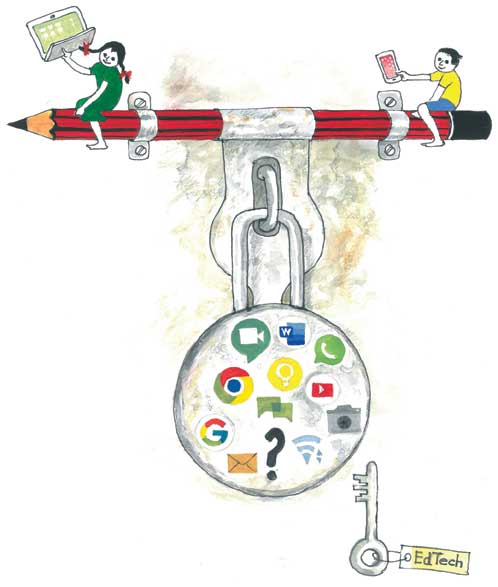Anand Krishnaswamy
Having created value, both in schools as well as in edtech organizations, I have had the advantage of picking the best (and the worst, but we shan’t discuss that) from both. I would like to keep the focus of this article on things that will help schools get better. As educators it behooves us to always seek ways to improve and learn even from quarters that some might hold as “the enemy”.
The debate between edtech and schools is never-ending. Sometimes it takes the form of concern over health (screentime, etc.) and sometimes it is about quality, sometimes it is about the shifting notions of ethics and sometimes it is about marketing. There is a visceral discomfort with subscribing to edtech and the money that is involved (whether it is about the CEO’s worth or advertisement campaigns or acquisitions or subscription costs, etc.). I am going to steer clear from all these distractions and instead identify a few key practices that schools can adopt to remain relevant, especially in a world revealed by a pandemic. Is there something that edtech organizations can learn from schools? Yes, but that is the substance of another article.
Readers will benefit from this article if they can re-key their brain to imagine these learnings from the best edtech service applied to the best school. If the reader is fervid in citing a poorly executed or fledgling edtech instance, then they should realize that there are far, far more schools that are in an unacceptable state to even claim that they can educate anyone. I prefer to focus on the child and find ways in which s/he might benefit from an improvement to any learning experience that s/he might have. Another common mistake is to think that all edtech companies are focusing on the tutoring aspect alone. There are edtech companies that focus on improving school digitization and reporting, etc. Hence, it would be beneficial to keep an open mind for the sake of a child’s learning. With that appeal to the educator in the reader, I present my key learnings as follows:
Where customer is king
No edtech company rejects a student. Schools are infamous for that. Yes, there is a fixed real-estate to blame for that, but with that comes a mindset which places the school (technically, the real-estate and the symbols) as more important than the student. Edtech companies by design are nearly subservient to the student. They will keep making their content delivery better, their recommendation engines better, their analytics better, their UI and UX (User Interface and User Experience) better and much more as a response to customer (students and/or school management) needs. If a student threatens to leave, they will want to know why and what they can do to make things better. If a student were to leave a school for another, the emptying-school will at most put out a vacancy notice. An edtech company will even let the student pick the theme for their ecosystem. A school doesn’t even include students in a discussion on uniform colour scheme (unless it is a topic for debate in some inter-school competition). Both of them charge fees – every year. The quality of material provided by edtech companies is on the rise with tablets, phygital extensions, glossy workbooks, etc., on offer. Schools, especially the state and central board schools, have the same quality of textbooks while an extremely small percentage of schools might offer something like a smart classroom. There is little value in listing the many ways in which edtech companies woo students and schools fail to do so.
Takeaway: Find ways to include students in the design, structure, and implementation, and yes, education delivered in school. The more they feel like the system is responsive and designed for them, the greater will be the value they associate with schools.

Trial and feedback
Edtech products continuously trial and test features and improvements. They might run beta tests or A/B tests or closed group feedback trials to see what works and what doesn’t. They will track every mouse movement to optimize the location of buttons and menu. Edtech companies obsess over Net Promoter Scores (NPS) and other points of feedback.
School education has rich opportunities to conduct Action Research and better understand the responses to interventions and new ideas. Unfortunately, the number of schools performing Action Research (or even being aware of what that is) is abysmally low. Schools will benefit from conducting experiments with each new batch of students (if not differentiating at the student level). Actively seeking feedback from students (even in the form of exit slips) on content, delivery, etc., will help teachers improve their trade. Seeking feedback from parents and students will help schools focus on areas of high impact improvement as well as identify areas of improvement and needs.
Takeaway: Actively invite feedback on school policies, practices, operations, facilities as well as education from students and parents alike. Include parents and students in experiment design and incorporate learnings to make education more rewarding and pertinent.
Data driven
With students included in the design as well as providing feedback, the next logical thing that schools must do is have a clear and open measurement scheme with data-driven decisioning. Defining and tracking data is key to edtech. Every single click, every engagement detail is captured and pored over. The earlier mentioned NPS is one of the data-points that drives further feedback gathering and data analysis. While they also gather tonnes of data to study their customer acquisitions and return subscriptions, etc., the amount of data collected about their students’ (and even teachers’/administrators’) behaviour and usage of the apps is significant thereby allowing them to drive their decisions based on data (including feedback). Often, the only datum that schools actively publish is the annual board exam pass percentage. Interestingly, given the unpredictable nature of these results, there are very few actionable steps that schools can take in response to this. But what helped achieve the result? What were the poor practices that harmed the results? From which grade should we start coaching students for board exam excellence? Is delaying the school start time by 15 min improving attentiveness in class? These are questions which beg to be answered with data and most schools do not have that. If this became a part of a school culture, then it would improve many aspects of running a school (and not just the academic and cognitive spheres).
Takeaway: Gather data with the intent of answering questions and informing strategy. Do not gather data to show off. Conduct experiments and gather data to check hypotheses. Make measurement and analysis of measurement a vital function of running the school.
Quality control
Edtech companies will typically hire qualified designers, content developers, media artists, sound engineers, instructional designers, pedagogy experts, copywriters, mentors, quality assurance and more to deliver a chapter of content. Apart from the user trials and rounds of feedback mentioned above, they also go through the scrutiny of multiple pairs of eyes. The advantage is in being able to deliver a uniformly high-quality learning experience.
Schools have a teacher, and sometimes, an HOD to achieve the same. CBSE just recently (2019) issued a circular to nudge the responsibility of “pedagogical leadership” on principals. The result is that some students curse their luck for the teacher they were assigned in that academic year, or worse, shrug shoulders because they are all the same. One of the core laments of people in the schooling industry is that all the best brains seem to go into the industry. Edtech companies also benefit from that and hire some very sharp minds. When Unacademy hired Manoj Chauhan as a faculty member, they actually ran an ad campaign about it! While schools might have a challenge in bidding for the best teachers, there is no reason they cannot invest in higher quality controls (which is not the same as more documentation) and staff professional development. The fear that if we train our teachers, they will leave for greener pastures, is an insecurity that schools employ to justify low investment in teacher training and improvement. What follows is disinterested teachers doling out insipid content. Teacher observations conducted to point flaws or justify termination benefits none. The Japanese Lesson Study method has been available to schools and teachers for well over 20 years but I have yet to hear of a single school in India that has applied it. Compare this to the number of companies that have adopted Total Quality Management (TQM). Schools which invest in improving the quality of teaching-learning material (TLM), teacher professional development, lesson planning, assessment practices, student-parent engagement, operations, communication and much more are significantly more likely to be held valuable to the education of the student.
Takeaway: Schools must invest in quality management of content, learning experience design and delivery. This must also transfer to every single aspect of school administration. Quality measures and metrics must be shared with all stakeholders along with corrective actions.

No physical boundaries
This is really a matter of reinventing one’s sphere of influence. Edtech companies (especially the tutoring ones) have allowed the student to take their learning wherever they go, even into their bathrooms. Where network connectivity is an issue, content was delivered on SDHC Cards. When on-screen work became an issue, phygital interfaces were brought in with image processing and sensors. Edtech constantly reinvents itself with the sole focus on providing the best, most engaging and immersive learning experiences. With the ability to implement research-based findings in the quickest manner (on a variety of devices and interfaces), edtech stands well-positioned to respond to various environmental challenges. Schools are not necessarily designed for agility. Even with the pandemic raging for over a year, schools are still trying to deliver the same content over Zoom and Meet. Students are still filling out answers in their notebooks which are being corrected as images photographed and sent over to teachers. If only schools actively invested in their own edtech (or partnered with edtech firms) to build proprietary educational platforms which would allow learning to continue in a variety of media, they would increase their likelihood to respond better to new environmental challenges.
Takeaway: Schools should actively invest in thriving and delivering value without boundaries. Schools should build and maintain themselves on a virtual platform by being available to students on a variety of media.
These are just some of the ways in which schools can consciously work towards being relevant and valued. Whatever else they might be doing in order to be the best – excellent student-teacher relationship, rich experiences, empathetic staff, etc. – should continue. Adopting these will only help make them better.
The author is a computer scientist reborn as an educationist. After many years in the research and consultation industry, he quit it all to teach in under-resourced schools in India, PYDS being the major episode. He can be reached at anand.krishnaswamy@gmail.com.
Related Article
